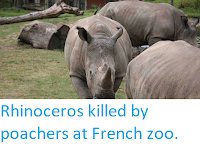A forty-year-old man has been arrested on suspicion of Rhinoceros poaching following a shootout with police in the Otjozondjupa Region of central Namibia on Sunday 8 September 2019. The incident happened after farmworkers alerted the Namibian Police Force that they had seen the man carrying a large hunting riffle near Farm Streben, about 40 km to the southwest of the town of Otavi. A group of fifteen armed police officers arrived at the scene, supported by members of the Namibian Defence Force, who approached the suspected but came under fire from him. After a sporadic exchange of shots lasting about two hours the man dropped his riffle and fled, but was tracked by helicopter and arrested some hours later. He was found to be in possession of ammunition and a piece of Rhino horn.
Hunting riffle dropped by a suspected poacher in the Otjozondjupa Region of central Namibia, following a shootout with police on 8 September 2019. Namibia Press Agency.
The incident occurred at Farm Streben, part of the Omutati Hunting and Guest Farm complex, which is adjacent to the Etosha National Park and allows hunting of a wide range of animals, but not Rhinoceros. The farm forms part of the Black Rhino Custodianship Programme, which seeks to restore the species to areas where they have previously been wiped out. Limited Rhinoceros hunting is allowed in Namibia, though only a very small number of permits is issued, these being sold by auction and typically selling for several hundred thousand US dollars. This practise is highly controversial, being almost universally condemned by conservation organisations, and several countries have passed laws against their citizens taking part in such activities.
A Black Rhinoceros, Diceros bicornis, in Namibia. Namibia Nature Foundation.
The Black Rhinoceros is considered to be Critically Endangered under the terms of the International Union for the Conservation of Nature's Red List of Threatened Species, almost entirely on the basis of the threat presented by poachers. The species formerly roamed across much of Central, East and Southern Africa, but has been wiped out in many areas. The total population is thought to have been about 850 000 in 1900, but to have dropped to about 2410 by 1995. Since then the population has benefited from careful management and protection from poachers, and reaches 4880 in 2010, though this means that many populations are living in carefully managed environments rather than being truly wild and free-ranging.
See also...
Follow Sciency Thoughts on Facebook.








